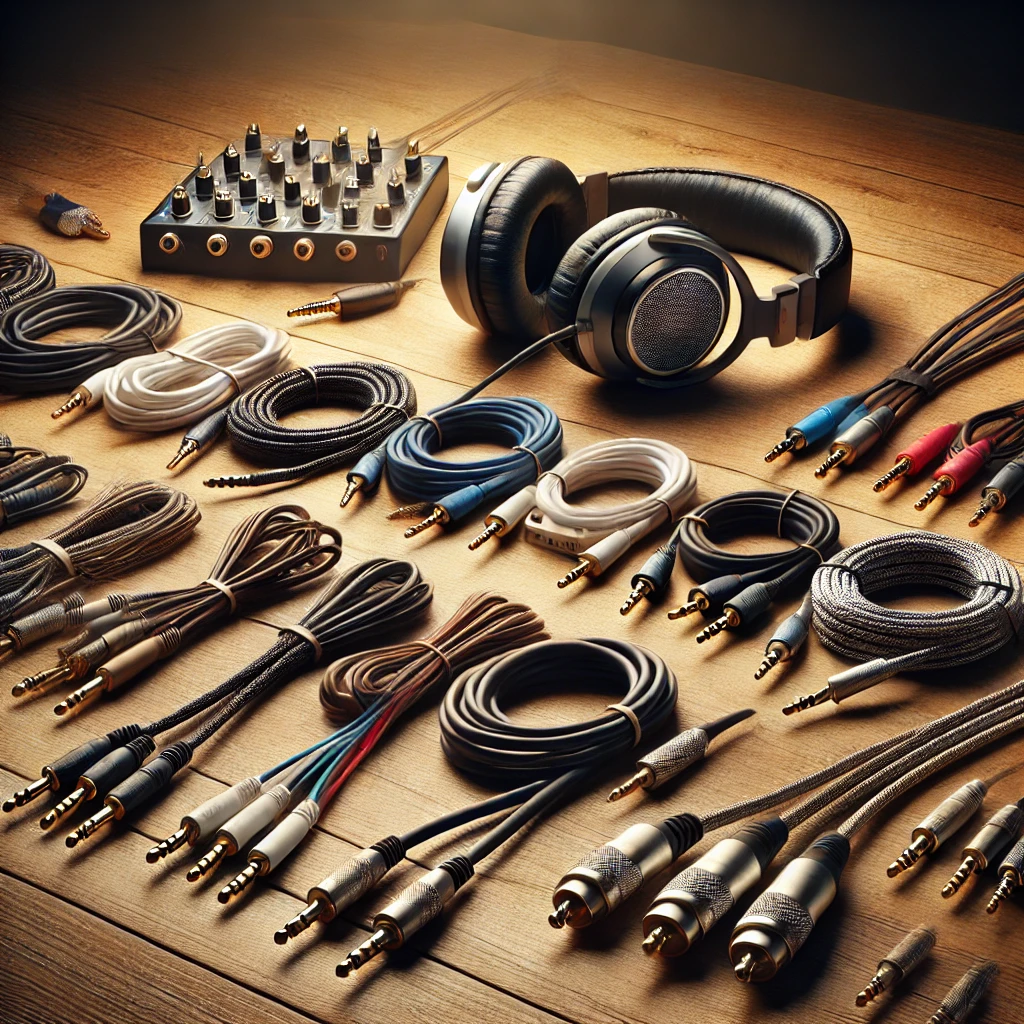Delivering high-quality music from your smartphone to your headphones depends much on stereo headphone cords. Understanding the several varieties of cables and their influence on sound quality is vital whether you are a casual listener or an audiophile. This all-inclusive manual will take you through the realm of stereo headphone cables, including insightful analysis of their kinds, advantages, and responses to several most often asked questions. You will know more by the end on how to choose the appropriate stereo headphone cable for your requirements.

Stereo Headphone Cables: What Are They?
The connection linking your headphones to an audio source—such as a smartphone, computer, or audio receiver—is called a stereo headphone cable. It sends stereo format audio signals—two distinct channels of sound (left and right) providing a richer sound experience. Usually, stereo headphone cables are made to fit 3.5mm or 6.3mm audio connectors, which work with most audio equipment.
Stereo cables can differ in length, material, and connector type, all of which can affect their durability as well as sound quality. These wires are absolutely essential to guarantee that your headphones provide clear, sharp sound.
Varieties of Stereo Headphone Cables
Stereo headphone cables don’t have a universal fit. Different kinds of cables perform various functions based on the device you are connecting to and the audio quality you want. The most usual kinds of stereo headphone wires listed below:
1. 3.5mm Stereo Headphone Cable
Regularly called the “aux cable,” the 3.5mm headphone wire is among the most regularly used connectors in consumer devices. Its compatibility includes tablets, laptops, smartphones, and many other audio devices. Available in standard and gold-plated varieties, the 3.5mm stereo port offers a balanced connection for sending high-quality audio to headphones.
Benefits:
- Compatible with most devices in many ways
- Cheap and easily accessible
- Simple to replace and replaceable
Drawbacks:
- Some high-end headphones have limited lower-end audio quality
- More affordable models are more susceptible to signal interference
2. Stereo Cable: 6.3mm (1/4-inch)
Usually found in professional audio equipment including high-end headphones and studio-grade gear, the 6.3mm (or 1/4-inch) stereo headphone wire offers superior audio fidelity. Due to their stronger wiring and better signal transmission, these cables are bigger and provide a higher degree of audio fidelity.
Benefits:
- Especially for audiophiles, better audio quality
- More robust and resistant to wear and tear
- Frequent in professional audio equipment
Drawbacks:
- Not suitable for many portable devices; an adapter is needed
- Larger size makes it less portable
3. Coiled Stereo Headphone Cables
Designed to expand and retract, coiled stereo cables are perfect for use in settings where mobility is critical. Professional audio systems, such as DJ booths or studio settings, often use these wires.
Benefits:
- Perfect for professional audio settings
- When not in use, flexible and small
Drawbacks:
- For casual use, it might not be as pleasant
- Improper storage can cause it to tangle
4. Detachable Stereo Headphone Cord
Some headphones include removable cords that let consumers upgrade or swap their wires. In the event of damage, detachable cables provide flexibility and let you configure your system using other kinds of cables, including balanced cables for better audio performance.
Benefits:
- Can be replaced if harmed
- Adjustable for particular audio configurations
- Excellent for premium audiophile headphones
Drawbacks:
- May cost more
- Some headphones lack removable wires
What Makes Stereo Headphone Cables Significant?
Though they are really basic, stereo headphone cables have a major influence on the quality of your listening session. Here are a few justifications for why the correct cable counts:
1. Sound Quality
The headphone cable’s main purpose is to send the audio signal to your headphones. A good cable guarantees that the signal travels without deterioration, hence keeping the richness and clarity of the music. Signal loss, distortion, or interference brought on by a poor-quality cable can produce an audio experience that is less than ideal.
2. Longevity
Especially if you are regularly on the go, stereo headphone wire could be worn and torn. Cheaper, lower-quality alternatives will not last as long or bear stress as well as a well-built cable composed of strong materials. A good cable guarantees you won’t have to replace it often.
3. Compatibility
The kind of equipment you use will determine which stereo headphone wire is best. From a 3.5mm port for a smartphone to a bigger 6.3mm socket for professional equipment, compatibility is very vital for getting the greatest performance. Many headphones provide replaceable wires for this purpose, hence letting users select the suitable link for their configuration.
4. Comfort
Your listening comfort is also influenced by the length and adaptability of the headphone wire. A coiled cable, for instance, can be handy for musicians or DJs; a longer straight line might be more comfortable for residential use. A detachable cable lets you change a worn-out wire without replacing the whole headphone.
Choosing the Correct Stereo Headphone Cable
Choosing a stereo headphone cable requires various considerations to guarantee you receive the finest cable for your requirements. Here are some important things to remember:
1. Length of Cable
Think about how far you must travel from your audio source. A three-foot wire could be enough if your desk will be where you listen to music. But, should you require greater freedom, search for longer wires—6-10 feet or more. Usually, shorter wires are preferable for portable use.
2. Cable Material
The endurance and sound quality of the cable might be influenced by its material. Gold-plated connections provide greater signal conductivity and are more corrosion-resistant. High-end audio devices also like cables made of oxygen-free copper (OFC) as they offer a more pure signal.
3. Cable Type and Use
Different cables fit various uses, as stated above. A 3.5mm cord will probably do if your smartphone is being used by a casual listener. For pros or audiophiles, nevertheless, spending on higher-end cables—such as 6.3mm or balanced cables—might provide better sound quality.
READ ABOUT:USB-C to Headphone Jack Adapters: All You Need to Know
Stereo Headphone Cable Frequently Asked Questions
1. How do a 3.5mm and a 6.3mm headphone wire differ?
The main distinction is in the plug size. Larger and usually found in professional audio equipment, a 6.3mm cable offers higher sound quality and longevity. Smaller and more often used with portable devices, a 3.5mm cable is suitable for casual use.
2. Are headphone wires with gold plating really worth it?
Gold-plated connectors do give higher conductivity and are more corrosion-resistant, hence guaranteeing a more robust and high-quality connection. Though they may not significantly enhance sound quality for casual listeners, they can benefit audiophiles.
3. May I use any headphone wire with my headphones?
Not really. Make sure the cable fits your audio device’s connector type as well as your headphones. Though some headphones include detachable wires that let you replace them for other choices, ensure the replacement cable is suitable.
4. Does sound quality change with cable length?
Although cable length does not directly influence music quality, longer cables could cause signal deterioration or interference, particularly if they are of poorer quality. To maximize performance, select a cable that fits your needs without unnecessary length.
5. How can I stop my headphone wires from snapping?
Excessive bending or pushing on the cables will cause wear and damage. Always keep the cable correctly while not in use; use clips or cable organizers to keep it tangle-free.
Final Thoughts
Delivering high-quality music to your headphones depends on stereo headphone cables. Whether you are a professional or a casual listener, knowing the many varieties of cables, their advantages, and how to select the appropriate one for your requirements will improve your whole audio experience. To choose the finest option for your system, always consider cable length, material, and compatibility.

